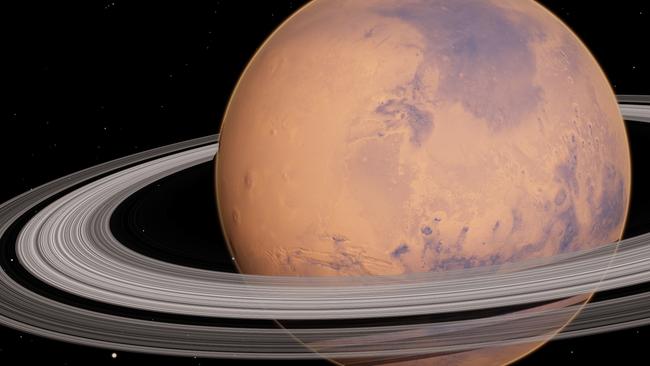Mars’ moon Phobos ‘breaking up’ as it slowly spirals towards destruction
MARS’ moon, Phobos, is doomed. It’s being slowly torn apart. But as it crumbles, it will give Mars a set of rings to rival the terrible beauty of Saturn.

MARS’ moon, Phobos, is doomed. It’s being slowly torn apart. But, in a mere 20 million years, its death shroud may surpass Saturn in its terrible beauty.
A study published in the science journal Nature Geoscience has found the moon is both losing altitude and showing signs of structural stress.
Essentially, the tidal forces of its close orbit — a mere 9330km above the surface of Mars — are slowly tearing it apart.

The battered moon hasn’t had it easy. Phobos was thumped by a giant impact long ago, resulting in a blast that left behind a 12km wide crater almost half as wide as the moon itself.
This left deep fractures through its core, says planetary scientists of the University of California.
A sign of this stress may be unusual grooves showing on the moon’s surface.
Previously thought to have been scratches left by small debris kicked up from Mars’s surface, the study says they are instead ‘stretchmarks’ revealing the strain Phobos is under.
“We think the grooves are signs that this body is starting to break apart tidally and that these are the first evidence of the tidal deformations of Phobos,” Terry Hurford, a planetary scientist with NASA’s Goddard Space Flight Center, told a meeting of the American Astronomical Society earlier this month. “Eventually, Phobos will be ripped apart before it reaches Mars’ surface.”

Phobos, the largest of Mars’ two moonlets, is slowly spiralling towards Mars’ atmosphere at a rate of one to two meters a century.
“While the largest chunks would eventually spiral into the planet and collide at a grazing angle to produce egg-shaped craters, the majority of the debris would circle the planet for millions of years until these pieces, too, drop onto the planet in ‘moon’ showers, like meteor showers. Only Mars’ other moon, Deimos, would remain,” a statement reads.
“Standing on the surface of Mars a few tens of millions of years from now, it would be pretty spectacular to watch,” UC Berkeley postdoctoral fellow Benjamin Black says.





